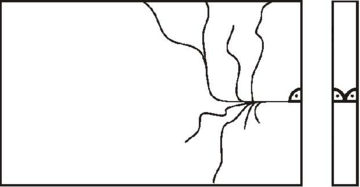- Home
- About IGU's
- Breakage
- Thermal cracks
Thermal cracks
Mechanical glass tensions caused by heat (when single-glass or insulating glass units are used for glazing) emerge in case of the difference in temperatures between two points of the glass surface.
Causes of the difference in temperatures:
- sunrays (the impact of the sun depends on the orientation of the glazing plane with regard to the cardinal points (North, East, etc.);
- conditioning and heating of the air in the premises (glass cracks may also appear due to the heating or cooling devices in the premises).
Theoretically, sun rays would not make any impact on thermal tensions of glass if the entire plane of glass were equally illuminated by sun and the temperature on the entire glass surface were distributed evenly. However, this happens very rarely in practice, as insulating glass units are fixed in the frame glazing groove and/or are partially in a shadow. That is why only thermally hardened or tempered glass should be used for glazing of non-transparent zones.
Heating and ventilation devices are most often installed near windows; therefore, they become a cause for thermal tensions because they form hot or cold zones on the glass surface.
The Table presented below shows typical cases of thermal tensions caused by the differences in temperature. Temperature differences caused by the sun are in many cases the result of the absorption characteristics of glass. Therefore, the emerging thermal tensions can be assessed taking into account the orientation of the building, climate zone and other parameters described in the Table (frames, shadows, curtains, etc.).
When the glass absorption index (EA) exceeds 50 %, the risk of thermal tension must be assessed and most often glass has to be processed as required in such cases.




















